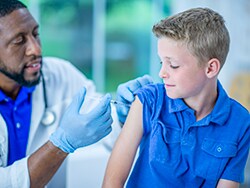How Much Do Doctors Make? [Salary by Specialty 2025]


It is unequivocal: The human papilloma virus (HPV) vaccine prevents cancer. It is safe and recommended by governmental and professional societies worldwide. Yet uptake is unacceptably low. This is particularly the case in boys; immunization rates for males aged 9 -26 years have yet to catch up with those of females, a group that also has not met the Healthy People 2020 goal of 80% coverage. This is despite the fact that the vaccine has been recommended for use in boys for a full decade.[1]

But maybe the tide is starting to turn. A recent study using National Immunization Survey—Teen data collected from 2011 to 2016 offers some hope.[2] The survey is a national random-digit-dialed telephone survey of teens aged 13-17 years and their families. Parents were asked whether they remembered if the child's provider recommended the HPV vaccine. In addition, medical providers of participating adolescents were contacted and asked to supply vaccination histories.
Researchers then correlated the parent's response regarding recommendations for the vaccine with information about the child's receipt of one or more doses. In 2016, there were more than 9000 eligible male adolescents in the survey.
Here's the good news: In 2016, almost two thirds of these teenagers (65.5%) had received a recommendation from their provider to receive the HPV vaccine, almost quadruple the rate who reported receiving such a recommendation in 2011 (14.2%). There was some variation by race and ethnicity of the child, with non-Hispanic white adolescents being the most likely to receive a provider recommendation (66.6%) and Asian teenagers the least likely (58.6%).
Income and maternal education level were positively related with having received a provider recommendation for the HPV vaccine; less than half of teenagers without health insurance (47.9%) were similarly encouraged.
Those recommendations do seem to be moving the needle. Between 2011 and 2016, HPV vaccination coverage among teenaged boys increased from 8.3% to 57.3%, which is a significant change. Although several factors contributed to this increase, the receipt of a provider recommendation remained significantly associated even after considering a number of other factors. Older adolescents (aged 16 to 17 years), black and Hispanic adolescents, those with Medicaid insurance, and those with two or more medical contacts in the 12 months prior to the interview were more likely to have been vaccinated. It is no surprise that boys who did not have a well-child visit when they were 11-12 years old were less likely to have been vaccinated.
I am encouraged by two findings from this study:
Roughly two thirds of the eligible males received at least one HPV vaccine.
A similar number received a recommendation for the HPV vaccine.
This is the glass-half-full perspective. The glass-half-empty view is that a full third of providers, and a similar number of their male adolescent patients, still aren't getting the message, even given the recent nature (2016) of these data.
We can address this issue by improving the frequency of health maintenance visits among young adolescents. There are increasing requirements for adolescent vaccines at middle- and high-school enrollment; therefore, targeting young teens with reminder-recall efforts for both health maintenance visits and vaccines, along with making a specific recommendation to receive the HPV vaccine, suggest a promising strategy to address multiple issues at once.
Follow Medscape on Facebook, Twitter, Instagram, and YouTube
Comments
Post a Comment